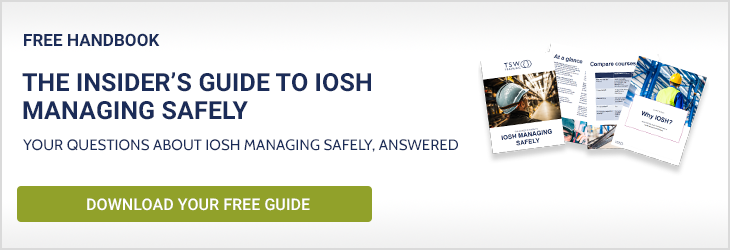The IOSH Managing safely course contains critical risk assessment training. It shows you what they are, why they’re needed and how to complete the IOSH risk assessment form accurately.
It’s one of the most important health and safety skills you can have, so much so, that IOSH will pass or fail you based on your risk assessment project. You must pass it as well as the exam to get your certificate.
⏰Key points:
- You must pass the project to gain your IOSH Managing Safely qualification and certificate
- You can’t copy an IOSH Managing Safely project example – your risk assessment must be unique to your workplace
- The assessment is based on your observations, opinions and risk score. You’ll pass if the examiner agrees with your reasoning
Download your free guide to the IOSH Managing Safely Course

What is the IOSH Managing Safely Risk Assessment project?
The risk assessment project is the final part of the IOSH Managing Safely course. It follows three days of training and a multiple-choice exam and you complete it in the two weeks which immediately follow your course.
You must pass the project to gain your qualification and certificate.
It’s a practical risk assessment – you’ll be asked to spot hazards and recommend how to remove or control them, to decrease the likelihood of harm or damage.
You complete the project in your own time, at work. The rest of the course can either be done online or at a training centre.
When and where do you complete the project?
The risk assessment is focused on your place of work and you complete it in the two weeks following your course.
There are subtle differences if you take the course virtually. You’d send the assessment to your trainer via Microsoft Teams (the software we use to deliver the virtual course). It’s marked and returned to you through Teams as well.
How long will it take?
You’ve got two weeks to complete the risk assessment project.
If you miss the deadline, you’ll have to re-sit the whole lot, so put the date in your diary. IOSH recommends you take two hours to observe the environment and record your findings.
What is the pass mark for IOSH Managing Safely?
Overall, you need 36 out of 60 to pass, but you must pass both the exam and project to get the qualification, To pass the project, you need to get 23 marks out of a possible 38.
In December 2019, 100% of our students passed the risk assessment with 33 marks or more.*
IOSH Managing Safely project examples
Your risk assessment must be unique to your workplace, based on your real opinion of the hazards which put your colleagues in harm’s way. You must train your brain to notice, record and rectify these hazards.
We’ll show you how to thoroughly complete the risk assessment to IOSH’s best practice standard, so you’ll pass the course and lead the way back at work.
Your trainer will go through each section, question-by-question. We don’t want you to forget any information when you’re out in the field so here’s a step-by-step guide for completing the project, and a few common pitfalls.
#1. Filling out your basic information
The questionnaire asks for the name of the assessor – put your name here, not the name of the examiner.
You also need to put the date and time you completed the form and the name of your training provider.
#2. Describe your place of work
Your description of the working environment should be very clear and factual.
Whoever marks your assessment isn’t familiar with your workplace, so precise and concise descriptions leave no room for misunderstanding. You may want to include:
- Function of space
- Size of space
- Number of people
When you’re finished, ask a friend who isn’t familiar with your work to read it through. If they can’t visualise where you work, start again.
#3. What task are you risk assessing?
Describe a specific situation.
Project answer examples:
As an example, you’re not just assessing a ‘walkie stacker’, you’re assessing the ‘walkie stacker lifting a 1,200lb pallet to a height of 2m’.
#4. Spot four hazards
You need to identify four hazards and each hazard is worth nine marks.
There are six types of hazard – mechanical, physical, chemical, environmental, biological and organisational. Using those categories, think carefully about how someone could come to harm if you do nothing.
If you list something that isn’t a hazard, or you’re woolly on the details, you won’t get any marks.
#5. How to describe the hazard
You must be specific to get the full nine marks.
- Where exactly is the hazard?
- What is the hazard?
- Why is it a hazard?
Will your assessor understand why the hazard was dangerous based on your description? Refine it until you’re sure that the relevant details are clear and there’s no room for miscommunication about the location and danger the hazard poses.
Project answer examples:
As an example of a vague description, imagine you were handed a risk assessment that listed ‘slips and trips’ with no context, you wouldn’t know where the risk was, or who’s at risk:
| Vague description | Precise description |
| Manual handling | Manual handling of boxes weighing more than 8kg in the warehouse |
| Slips | Slip hazard at the entrance of the warehouse walk-in fridge, caused by a leaking water pipe inside the door |
#6. Who is at risk?
List all the people who could come to harm if you don’t sort the hazard out. Don’t forget about visitors, cleaning and maintenance staff, as well as workers. Use job titles, or departments, rather than names.
Not all people encounter every hazard
Even in a busy, high-risk workplace, not every person in the building will encounter your four hazards.
Ask supervisors and managers about who’s got access to the space and when, perhaps even what task they’re doing, so you can be more specific about who’s at risk.
A supermarket customer, for instance, doesn’t have access to the building’s warehouse, so they aren’t at risk of slipping on a wet floor near the walk-in fridge.
And, although the cleaning team isn’t supposed to move boxes in the warehouse, they are at risk if they have to move boxes to mop the floor.
#7. Describe the harm
You must also describe how people might be harmed. This section allows you to assess the severity of the hazard – how likely, if left in its current state, is the hazard to kill someone?
Project answer examples:
As an example, if someone slipped on a wet surface:
| Immediate and obvious injuries | Long-term health implications | Is it life ending? |
| Cuts, bruises, bone fractures and breaks, headaches and concussion | Torn tendons and ligaments, muscular or brain injuries which need ongoing treatment, therapy and care | There’s a risk of injury-related death if they slip and bang their head or slip and fall from a height |
#8. Existing risk controls
Unless you work in a health and safety void, there will be some risk controls in place to safeguard against the hazards you can see:
- Physical signage pointing out the hazard
- Health and safety rules or instructions on the walls around the hazard
- Equipment or machinery that’s been brought in to reduce the risk
- Alternatives to the hazard – for example, there’s a tower scaffold which is in regular use, but the ladder has stayed in the stockroom
- Engineering solutions which are meant to contain or guard the hazard
- Protective clothing worn by staff – that could be helmets, goggles, gloves and boots, or hazmat suits
#9. Give it an inherent risk rating
During your course, you’ll be shown how to use the IOSH (5×5) risk calculator.
What is a 5×5 risk matrix?
A 5×5 risk matrix helps you define the level of risk and allows you to see the liklihood and probability of risk at a glance.
There’s a skill to assigning a realistic score that often comes with practice and experience. Your trainer will share their practical examples with you, so you won’t dramatise or over-edit your consequence rating.
Give the hazard a likelihood rating and a consequence rating. Multiply them together to find the risk rating.
Likelihood scores
| Score | Description |
| 1 | Very unlikely |
| 2 | Unlikely |
| 3 | Fairly likely |
| 4 | Likely |
| 5 | Very likely |
Consequence score
| Score | Description |
| 1 | Insignificant, no injury |
| 2 | Minor, but needs first aid |
| 3 | Moderate, three days absence |
| 4 | Major, more than seven days of absence |
| 5 | Catastrophic, death |
Your assessment reflects your opinion of the hazard and situation, but your consequence rating must be realistic.
Realistically, if you’re working at height you could fall and die. Realistically, faulty wiring could give you an electric shock and heart failure.
Your risk rating must tally up with the examiner’s opinion to pass, so if you think a consequence of death is unlikely, soften your consequence score.
#10. What additional controls would make the situation safer?
Skip back to your list of existing controls and see what’s missing.
There are softer controls that would help reduce the likelihood score too. That could be training, supervision, processes and inspections.
Again, be very realistic about how much impact softer controls would have if the consequence score is leaning towards catastrophic.
#11. Give it a residual risk rating
If those controls were in place, what would the new risk rating be?
As before, use the IOSH 5×5 risk calculator to calculate likelihood and consequence.
By using your suggested control, you’ve reduced the risk and therefore the likelihood of harm score is smaller.
#12. Should you change the consequence score?
The consequence score probably won’t change because unless you switch out a harmful substance or toxin, the consequence of encountering the hazard might still lead to death.
#13. Action monitored by whom
In this section, assign who will action your recommendations and get the hazard under control. Ask HR and facilities if you need support finding the right person for the job.
Rather than naming names, assign job titles. If anyone critical to your risk management plan leaves the company, the responsibility remains with that position.
#14. Action monitored and review date
The combined likelihood and consequence rating reveals how urgently your business needs to take action.
Use the IOSH action level table to inform your decision about time frames. If the combined likelihood and consequence score is very high, the change needs to be made swiftly, but a lower score allows for more time.
You must give a specific review date to get the mark, so have your calendar to hand. Non-specific time frames, for instance, ‘one week, ‘one month’ ‘one year’ or even worse, ‘ongoing’, will lose the mark.
How to submit your completed risk assessment
Once you’ve finished the risk assessment project, check you’ve completed every empty field and signed the paperwork.
Ask one of your colleagues to read it through and check you haven’t missed anything. Your training provider will ask you to submit the assessment digitally or hand it in at the test centre. You employer may send it on your behalf.
Your training provider marks the exam and assessment on behalf of IOSH using its marking criteria.
When will you get the results and certificate?
You’ll get your results and certificate within 12 weeks of submitting the risk assessment project. Once you get your certificate, you can get it verified by IOSH.
If you fail the assessment, you’ll get a phone call or email from your training provider and you can ask for feedback about what went wrong.
Any further questions?
If you’d like to know more about IOSH, the courses they offer and whether they’re the right course for you and your organisation, take a look at our IOSH FAQ page or get in touch with our team of IOSH experts.
*12 learners took the risk assessment and passed with 33 marks or more – 36, 37, 35, 38, 33, 38, 38, 38, 33, 38, 37 and 38.







